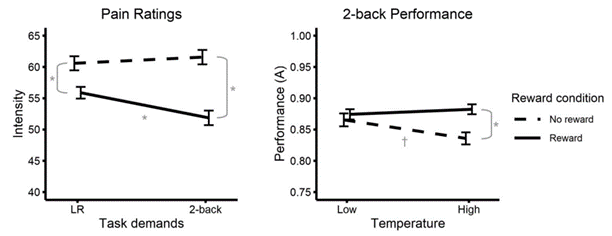Current Research in the Lab Follows Five Main Axes…
1. Effects of competing goals on pain perception
Pain commands us to react to potential tissue damage. However, pain also leaves some flexibility in how and when to respond to it. For instance, we may prefer to finish an important activity before attending to a minor injury. Every second, we are bombarded with a multitude of sensory inputs from the environment or from our body, but our brains can only process a fraction of that information at any given time. Subjectively perceived pain should therefore be conceived as the result of the competition between incoming nociceptive signals and other valued activities for access to limited cognitive resources. To study this phenomenon, we employ challenging cognitive tasks like the n-back (Tabry et al., Sci Rep, 2021, Vogel et al. eLife, 2022, Vogel et al. Pain Reports, 2022, Vogel et al., under review) and enjoyable activities such as playing video games (Deldar et al., in prep.) or chess (Deldar et al., in prep.) to explore how competing goals can mitigate pain perception.
Monetary rewards amplify the pain-reducing effects of performing a cognitively demanding 2-back task and prevent performance from being affected by painful temperatures (Vogel et al., Pain Reports, 2022).
2. Investigating the role of the mesolimbic dopamine reward system in music-induced hypoalgesia
Effects of music on pain (Valevicius et al., in prep.). Sixty-three participants rated the pain produced by thermal stimulations while listening to music from music-care, scrambled music from music-care, their preferred music, silence, and scrambled music control conditions. Pain was significantly reduced in music conditions vs. their scrambled controls or silence (all p’s < 0.05). However, preferred music produced the strongest analgesic effects, outperforming the music-care control (music-care > preferred music, p < 0.001).
Pain not only serves as a warning signal, but it also teaches us to identify and avoid future threats. Studies in the lab have shown that perceived pain (Taylor et al., Pain, 2016, Taylor et al., Psychosom Med, 2018) and pain-related brain activity (Roy et al., Nat Neuro, 2014, Jepma et al., eLife, 2022, Coll et al., in prep.) correlate with the prediction error signals necessary to learn from unexpected pain. In a subsequent set of studies, we demonstrated that the mesolimbic reward system encodes a shared value representation that serves to assess the right price to pay to avoid pain (Slimani et al., Eur J Pain, 2022, Coll et al., PNAS, 2022).
Music has been used in the service of healing illnesses and relieving pain for much of recorded history. Although music's efficacy in relieving pain is now well-established, our lack of understanding of music's mechanisms of action prevents us from exploiting its full therapeutic potential. Several studies in the lab have demonstrated that music’s perceived pleasantness is a key ingredient of music-induced hypoalgesia (Roy et al., Pain, 2008, Roy et al., Eur J Pain, 2013, Valevicius et al., in prep.). Future research projects in the lab will aim at testing the hypothesis that MIH is caused by dopamine release in the mesolimbic reward system.
3. Learning to predict and avoid pain
Cross-prediction of pain and monetary offers (Coll et al., PNAS, 2022). Results for the whole-brain cross-prediction searchlight analysis in which a principal component regression was trained on pain or money offers and tested on the other modality (P < 0.05, FWE corrected using a bootstrap distribution built from 5,000 samples drawn with replacement). Unthresholded striatum z-scored weights for the (D) PVP and the (E) MVP.
4. Effects of physical exercise on chronic low back pain
According to the 2017 Global Burden of Disease Survey, chronic low back pain (CLBP) is the number one cause of years lived with disability in Canada and worldwide. Unfortunately, current treatments either lack efficacy, have dose limiting side-effects or involve the use of addictive substances. Luckily, one of our best hopes of treatment for CLBP appears to be physical exercise training. Studies in the lab demonstrated that the therapeutic effects of physical exercise therapy are mediated by reduced Nac-mPFC connectivity (Bergevin et al., in prep., Thompson et al., in prep.). Future research in the lab will aim at assessing the impact of physical exercise on systemic inflammation and dopamine function in the mesolimbic reward system.
A 14-week exercise training program led to significant decreases in pain (p < 0.0001, n = 27,26, controls and exercise, respectively), disability (ODI: p = 0.002), pain catastrophizing (PCS: p = 0.013), and trait anxiety (T-ANX: p = 0.049), and reduces Nac-mPFC connectivity.
Pooled results from objective outcomes reflected a significant moderate effect (g = -0.47), in favor of better performance by healthy controls across broad domains. No significant differences across investigated domains were found [(Q(5) = 7.5, p = 0.186].
5. Cognitive deficits in chronic pain
Chronic pain is associated with several symptoms such as fatigue, negative affect, reduced motivation and cognitive deficits. These concurrent issues, specifically cognitive deficits, can further contribute to chronic-pain related disability. A recent meta-analysis conducted in our lab, combined with findings from the UK biobank, showed that the deficits associated with chronic pain are mild-to-moderate in intensity and distributed across a myriad domains of cognitive functioning (Gentile et al., submitted). Ongoing research in the lab aims at uncovering the motivational and neural dysfunction that underly cognitive deficits in fibromyalgia syndrome (Gentile et al., in prep.).





